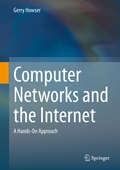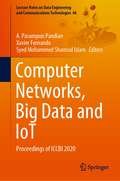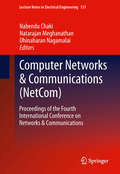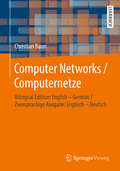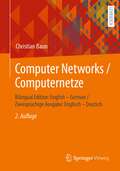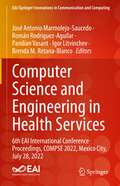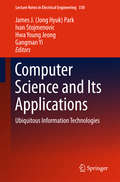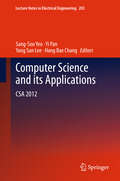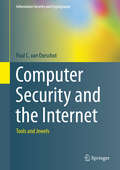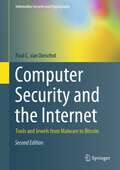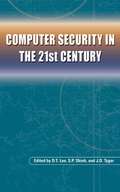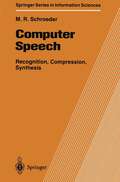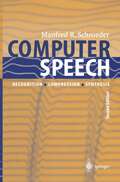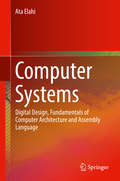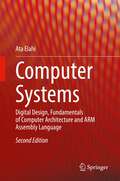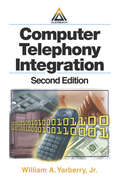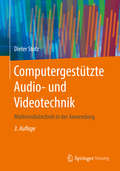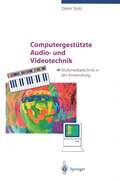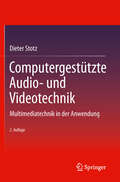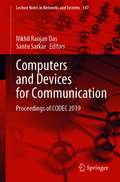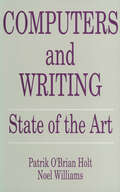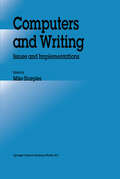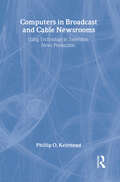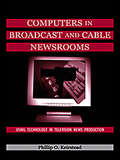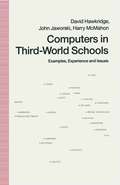- Table View
- List View
Computer Networks and the Internet: A Hands-On Approach
by Gerry HowserThe goal of this textbook is to provide enough background into the inner workings of the Internet to allow a novice to understand how the various protocols on the Internet work together to accomplish simple tasks, such as a search. By building an Internet with all the various services a person uses every day, one will gain an appreciation not only of the work that goes on unseen, but also of the choices made by designers to make life easier for the user.Each chapter consists of background information on a specific topic or Internet service, and where appropriate a final section on how to configure a Raspberry Pi to provide that service.While mainly meant as an undergraduate textbook for a course on networking or Internet protocols and services, it can also be used by anyone interested in the Internet as a step–by–step guide to building one's own Intranet, or as a reference guide as to how things work on the global Internet
Computer Networks, Big Data and IoT: Proceedings of ICCBI 2020 (Lecture Notes on Data Engineering and Communications Technologies #66)
by A. Pasumpon Pandian Xavier Fernando Syed Mohammed Shamsul IslamThis book presents best selected research papers presented at the International Conference on Computer Networks, Big Data and IoT (ICCBI 2020), organized by Vaigai College Engineering, Madurai, Tamil Nadu, India, during 15–16 December 2020. The book covers original papers on computer networks, network protocols and wireless networks, data communication technologies and network security. The book is a valuable resource and reference for researchers, instructors, students, scientists, engineers, managers and industry practitioners in those important areas.
Computer Networks & Communications: Proceedings of the Fourth International Conference on Networks & Communications (Lecture Notes in Electrical Engineering #131)
by Nabendu Chaki, Natarajan Meghanathan and Dhinaharan NagamalaiComputer Networks & Communications (NetCom) is the proceedings from the Fourth International Conference on Networks & Communications. This book covers theory, methodology and applications of computer networks, network protocols and wireless networks, data communication technologies, and network security. The proceedings will feature peer-reviewed papers that illustrate research results, projects, surveys and industrial experiences that describe significant advances in the diverse areas of computer networks & communications.
Computer Networks / Computernetze: Bilingual Edition: English – German / Zweisprachige Ausgabe: Englisch – Deutsch
by Christian BaunMit diesem Buch erlangen Sie Grundlagenwissen im Bereich der ComputernetzwerkeDieses Buch bietet Ihnen einen kompakten Überblick über das Thema Computernetzwerke. Sein Aufbau orientiert sich an den Schichten der etablierten Referenzmodelle und behandelt für jede Schicht die Geräte und die wichtigsten Protokolle. Zu den Protokollen gehören auch Netzwerktechnologien wie Ethernet, WLAN, Bluetooth usw. und die Übertragungsmedien.Das Ziel des Buches ist es nicht, eine Auflistung von Algorithmen zu schaffen, sondern eine an der Realität orientierte Beschreibung zu liefern, die die wichtigsten Technologien in einem klaren Zusammenhang behandelt. Das Buch soll dem Leser ein fundiertes Verständnis von Computernetzwerken in kompakter Form vermitteln.Das Besondere dabei ist die zweisprachige Darstellung des Inhalts. In zwei Spalten stehen der deutsche und der englische Text nebeneinander, so dass der Leser gleichzeitig seine Sprachkenntnisse und sein Fachvokabular verbessern kann. Das Buch richtet sich vor allem an Studierende der Informatik und an alle am Thema Interessierten. Diese Inhalte vermittelt der Autor dem LeserChristian Baun vermittelt dem Leser in seinem Buch alle wichtigen Grundlagen der Computernetzwerke. Dazu gehören unter anderen:· Grundlagen der Informations- und Netzwerktechnik· Grundlagen der Computervernetzung· Protokolle und Protokollschichten· Bitübertragungsschicht· Sicherungsschicht· Vermittlungsschicht· Transportschicht· Anwendungsschicht· Netzwerkvirtualisierung· Funktionsweise des OSI-Referenzmodells· Kommandozeilenwerkzeuge Mithilfe dieser Inhalte erhält der Leser einen kompakten Einblick in die Thematik.---This book presents a compact, yet detailed overview and introduction to computer networks and their components. The book is written in both English and German, arranged in side-by-side columns. This feature helps readers improve and broaden their language skills, and gain familiarity with the specialized vocabulary of computer science and networking at the same time. The book opens with a review of computer science basics, including the building blocks of data, file and storage dimensions, and Unicode. The fundamentals of computer networking are presented, with sections on the dimensions of different types of networks, data transmission, and media access control. Protocols and reference models are explained, followed by chapters on the functional layers of networks: Physical Layer, Data Link Layer, Network Layer, Transport Layer, and Application Layer. Additional topics covered include:· Computer network topologies· Bandwidth and latency· Network virtualization The book includes a collection of command line tools for network configuration and for analyzing network-related issues. The book concludes with a list of technical terms, and an extensive glossary, both presented in side-by-side columns, in English and German. Requiring little to no technical background, Computer Networks – Computernetze benefits college-level students interested in computer science. It is especially useful for students and working professionals who wish to improve their knowledge of networks and to gain greater comprehension of the technical language of computing in either German or English.
Computer Networks / Computernetze: Bilingual Edition: English – German / Zweisprachige Ausgabe: Englisch – Deutsch
by Christian BaunMit diesem Buch erlangen Sie Grundlagenwissen im Bereich der ComputernetzwerkeDieses Buch bietet Ihnen einen kompakten Überblick über das Thema Computernetzwerke. Sein Aufbau orientiert sich an den Schichten der etablierten Referenzmodelle und behandelt für jede Schicht die Geräte und die wichtigsten Protokolle. Zu den Protokollen gehören auch Netzwerktechnologien wie Ethernet, WLAN, Bluetooth usw. und die Übertragungsmedien.Das Ziel des Buches ist es nicht, eine Auflistung von Algorithmen zu schaffen, sondern eine an der Realität orientierte Beschreibung zu liefern, die die wichtigsten Technologien in einem klaren Zusammenhang behandelt. Das Buch soll dem Leser ein fundiertes Verständnis von Computernetzwerken in kompakter Form vermitteln.Das Besondere dabei ist die zweisprachige Darstellung des Inhalts. In zwei Spalten stehen der deutsche und der englische Text nebeneinander, so dass der Leser gleichzeitig seine Sprachkenntnisse und sein Fachvokabular verbessern kann. Das Buch richtet sich vor allem an Studierende der Informatik und an alle am Thema Interessierten. Diese Inhalte vermittelt der Autor dem LeserChristian Baun vermittelt dem Leser in seinem Buch alle wichtigen Grundlagen der Computernetzwerke. Dazu gehören unter anderen:· Grundlagen der Informations- und Netzwerktechnik· Grundlagen der Computervernetzung· Protokolle und Protokollschichten· Bitübertragungsschicht· Sicherungsschicht· Vermittlungsschicht· Transportschicht· Anwendungsschicht· Netzwerkvirtualisierung· Funktionsweise des OSI-Referenzmodells· Kommandozeilenwerkzeuge Mithilfe dieser Inhalte erhält der Leser einen kompakten Einblick in die Thematik.---This book presents a compact, yet detailed overview and introduction to computer networks and their components. The book is written in both English and German, arranged in side-by-side columns. This feature helps readers improve and broaden their language skills, and gain familiarity with the specialized vocabulary of computer science and networking at the same time. The book opens with a review of computer science basics, including the building blocks of data, file and storage dimensions, and Unicode. The fundamentals of computer networking are presented, with sections on the dimensions of different types of networks, data transmission, and media access control. Protocols and reference models are explained, followed by chapters on the functional layers of networks: Physical Layer, Data Link Layer, Network Layer, Transport Layer, and Application Layer. Additional topics covered include:· Computer network topologies· Bandwidth and latency· Network virtualization The book includes a collection of command line tools for network configuration and for analyzing network-related issues. The book concludes with a list of technical terms, and an extensive glossary, both presented in side-by-side columns, in English and German. Requiring little to no technical background, Computer Networks – Computernetze benefits college-level students interested in computer science. It is especially useful for students and working professionals who wish to improve their knowledge of
Computer Science and Engineering in Health Services: 6th EAI International Conference Proceedings, COMPSE 2022, Mexico City, July 28, 2022 (EAI/Springer Innovations in Communication and Computing)
by José Antonio Marmolejo-Saucedo Román Rodríguez-Aguilar Pandian Vasant Igor Litvinchev Brenda M. Retana-BlancoThis book constitutes the refereed post-conference proceedings of the 6th EAI International Conference Computer on Science and Engineering in Health Services (COMPSE 2022), which took place in Mexico City and online, June 28th, 2022. The papers are grouped on thematic topics: application of tools delivered by the COVID-19 pandemic; health services; computer and data science; and industry 4.0 in logistics and supply chain. The content is relevant to researchers, academics, students and professionals.
Computer Science and its Applications: Ubiquitous Information Technologies (Lecture Notes in Electrical Engineering #330)
by James J. Park Hwa Young Jeong Ivan Stojmenovic Gangman YiThe 6th FTRA International Conference on Computer Science and its Applications (CSA-14) will be held in Guam, USA, Dec. 17 - 19, 2014. CSA-14 presents a comprehensive conference focused on the various aspects of advances in engineering systems in computer science, and applications, including ubiquitous computing, U-Health care system, Big Data, UI/UX for human-centric computing, Computing Service, Bioinformatics and Bio-Inspired Computing and will show recent advances on various aspects of computing technology, Ubiquitous Computing Services and its application.
Computer Science and its Applications: CSA 2012 (Lecture Notes in Electrical Engineering #203)
by Sang-Soo Yeo, Yi Pan, Yang Sun Lee and Hang Bae ChangThe 4th FTRA International Conference on Computer Science and its Applications (CSA-12) will be held in Jeju, Korea on November 22~25, 2012. CSA-12 will be the most comprehensive conference focused on the various aspects of advances in computer science and its applications. CSA-12 will provide an opportunity for academic and industry professionals to discuss the latest issues and progress in the area of CSA. In addition, the conference will publish high quality papers which are closely related to the various theories and practical applications in CSA. Furthermore, we expect that the conference and its publications will be a trigger for further related research and technology improvements in this important subject. CSA-12 is the next event in a series of highly successful International Conference on Computer Science and its Applications, previously held as CSA-11 (3rd Edition: Jeju, December, 2011), CSA-09 (2nd Edition: Jeju, December, 2009), and CSA-08 (1st Edition: Australia, October, 2008).
Computer Security and the Internet: Tools and Jewels (Information Security and Cryptography)
by Paul C. van OorschotThis book provides a concise yet comprehensive overview of computer and Internet security, suitable for a one-term introductory course for junior/senior undergrad or first-year graduate students. It is also suitable for self-study by anyone seeking a solid footing in security – including software developers and computing professionals, technical managers and government staff. An overriding focus is on brevity, without sacrificing breadth of core topics or technical detail within them. The aim is to enable a broad understanding in roughly 350 pages. Further prioritization is supported by designating as optional selected content within this. Fundamental academic concepts are reinforced by specifics and examples, and related to applied problems and real-world incidents. The first chapter provides a gentle overview and 20 design principles for security. The ten chapters that follow provide a framework for understanding computer and Internet security. They regularly refer back to the principles, with supporting examples. These principles are the conceptual counterparts of security-related error patterns that have been recurring in software and system designs for over 50 years. The book is “elementary” in that it assumes no background in security, but unlike “soft” high-level texts it does not avoid low-level details, instead it selectively dives into fine points for exemplary topics to concretely illustrate concepts and principles. The book is rigorous in the sense of being technically sound, but avoids both mathematical proofs and lengthy source-code examples that typically make books inaccessible to general audiences. Knowledge of elementary operating system and networking concepts is helpful, but review sections summarize the essential background. For graduate students, inline exercises and supplemental references provided in per-chapter endnotes provide a bridge to further topics and a springboard to the research literature; for those in industry and government, pointers are provided to helpful surveys and relevant standards, e.g., documents from the Internet Engineering Task Force (IETF), and the U.S. National Institute of Standards and Technology.
Computer Security and the Internet: Tools and Jewels from Malware to Bitcoin (Information Security and Cryptography)
by Paul C. van OorschotThis book provides a concise yet comprehensive overview of computer and Internet security, suitable for a one-term introductory course for junior/senior undergrad or first-year graduate students. It is also suitable for self-study by anyone seeking a solid footing in security – including software developers and computing professionals, technical managers and government staff. An overriding focus is on brevity, without sacrificing breadth of core topics or technical detail within them. The aim is to enable a broad understanding in roughly 350 pages. Further prioritization is supported by designating as optional selected content within this. Fundamental academic concepts are reinforced by specifics and examples, and related to applied problems and real-world incidents. The first chapter provides a gentle overview and 20 design principles for security. The ten chapters that follow provide a framework for understanding computer and Internet security. They regularly refer back to the principles, with supporting examples. These principles are the conceptual counterparts of security-related error patterns that have been recurring in software and system designs for over 50 years. The book is “elementary” in that it assumes no background in security, but unlike “soft” high-level texts it does not avoid low-level details, instead it selectively dives into fine points for exemplary topics to concretely illustrate concepts and principles. The book is rigorous in the sense of being technically sound, but avoids both mathematical proofs and lengthy source-code examples that typically make books inaccessible to general audiences. Knowledge of elementary operating system and networking concepts is helpful, but review sections summarize the essential background. For graduate students, inline exercises and supplemental references provided in per-chapter endnotes provide a bridge to further topics and a springboard to the research literature; for those in industry and government, pointers are provided to helpful surveys and relevant standards, e.g., documents from the Internet Engineering Task Force (IETF), and the U.S. National Institute of Standards and Technology.
Computer Security in the 21st Century
by D. T. Lee S. P. Shieh J. Doug TygarComputer Security in the 21st Century shares some of the emerging important research trends reflected in recent advances in computer security, including: security protocol design, secure peer-to-peer and ad hoc networks, multimedia security, and intrusion detection, defense and measurement. Highlights include presentations of : - Fundamental new security - Cryptographic protocols and design, - A new way of measuring network vulnerability: attack surfaces, - Network vulnerability and building impenetrable systems, - Multimedia content protection including a new standard for photographic images, JPEG2000. Researchers and computer security developers will find in this book interesting and useful insights into building computer systems that protect against computer worms, computer viruses, and other related concerns.
Computer Speech: Recognition, Compression, Synthesis (Springer Series in Information Sciences #35)
by Manfred R. SchroederNew material treats such contemporary subjects as automatic speech recognition and speaker verification for banking by computer and privileged (medical, military, diplomatic) information and control access. The book also focuses on speech and audio compression for mobile communication and the Internet. The importance of subjective quality criteria is stressed. The book also contains introductions to human monaural and binaural hearing, and the basic concepts of signal analysis. Beyond speech processing, this revised and extended new edition of Computer Speech gives an overview of natural language technology and presents the nuts and bolts of state-of-the-art speech dialogue systems.
Computer Speech: Recognition, Compression, Synthesis (Springer Series in Information Sciences #35)
by Manfred R. SchroederNew material treats such contemporary subjects as automatic speech recognition and speaker verification for banking by computer and privileged (medical, military, diplomatic) information and control access. The book also focuses on speech and audio compression for mobile communication and the Internet. The importance of subjective quality criteria is stressed. The book also contains introductions to human monaural and binaural hearing, and the basic concepts of signal analysis. Beyond speech processing, this revised and extended new edition of Computer Speech gives an overview of natural language technology and presents the nuts and bolts of state-of-the-art speech dialogue systems.
Computer Systems: Digital Design, Fundamentals of Computer Architecture and Assembly Language
by Ata ElahiThis textbook covers digital design, fundamentals of computer architecture, and assembly language. The book starts by introducing basic number systems, character coding, basic knowledge in digital design, and components of a computer. The book goes on to discuss information representation in computing; Boolean algebra and logic gates; sequential logic; input/output; and CPU performance. The author also covers ARM architecture, ARM instructions and ARM assembly language which is used in a variety of devices such as cell phones, digital TV, automobiles, routers, and switches. The book contains a set of laboratory experiments related to digital design using Logisim software; in addition, each chapter features objectives, summaries, key terms, review questions and problems. The book is targeted to students majoring Computer Science, Information System and IT and follows the ACM/IEEE 2013 guidelines. • Comprehensive textbook covering digital design, computer architecture, and ARM architecture and assembly • Covers basic number system and coding, basic knowledge in digital design, and components of a computer • Features laboratory exercises in addition to objectives, summaries, key terms, review questions, and problems in each chapter
Computer Systems: Digital Design, Fundamentals of Computer Architecture and ARM Assembly Language
by Ata ElahiThis updated textbook covers digital design, fundamentals of computer architecture, and ARM assembly language. The book starts by introducing computer abstraction, basic number systems, character coding, basic knowledge in digital design, and components of a computer. The book goes on to discuss information representation in computing, Boolean algebra and logic gates, and sequential logic. The book also presents introduction to computer architecture, Cache mapping methods, and virtual memory. The author also covers ARM architecture, ARM instructions, ARM assembly language using Keil development tools, and bitwise control structure using C and ARM assembly language. The book includes a set of laboratory experiments related to digital design using Logisim software and ARM assembly language programming using Keil development tools. In addition, each chapter features objectives, summaries, key terms, review questions, and problems.
Computer Telephony Integration
by William A. Yarberry Jr.Since the publication of the first edition, the CTI world has changed significantly. Where it was once focused on the integration of voice systems with computers, the focus is now on IP-based voice, or converged networks and services. Today, the telcos are upgrading their systems from circuit-switched to IP-based packet-switched networks. Companies
Computergestützte Audio- und Videotechnik: Multimediatechnik in der Anwendung
by Dieter StotzDiese Einführung in die moderne Audio- und Videotechnik ermöglicht Lesern mit technischem Grundverständnis einen leichten Einstieg – auch in komplexe Zusammenhänge. Der Autor vermittelt detailliertes Wissen, praxisnah und verständlich aufbereitet: von den Grundlagen der Ton- und Videotechnik über Abtastung und Digitalisierung, räumliches Hören, Datenkompression, MIDI-Standard und -Signale, digitale Audiomesstechnik bis zu hochauflösender Videotechnik, Genlock, Chromakeying, Schnittsystemen und Animation. Mit vielen Graphiken und Abbildungen.
Computergestützte Audio- und Videotechnik: Multimediatechnik in der Anwendung
by Dieter StotzLeicht verständlich, klar strukturiert und mit vielen technischen Tips führt das Buch in die Anwendung der ton- und bildverarbeitenden Computersysteme ein.
Computergestützte Audio- und Videotechnik: Multimediatechnik in der Anwendung
by Dieter StotzDiese Einführung in die moderne Audio- und Videotechnik ermöglicht Lesern mit technischem Grundverständnis einen leichten Einstieg – auch in komplexe Zusammenhänge. Der Autor vermittelt detailliertes Wissen, praxisnah und verständlich aufbereitet: von den Grundlagen der Ton- und Videotechnik über Abtastung und Digitalisierung, räumliches Hören, Datenkompression, MIDI-Standard und -Signale, digitale Audiomesstechnik bis zu hochauflösender Videotechnik, Genlock, Chromakeying, Schnittsystemen und Animation. Mit vielen Graphiken und Abbildungen.
Computers and Devices for Communication: Proceedings of CODEC 2019 (Lecture Notes in Networks and Systems #147)
by Nikhil Ranjan Das Santu SarkarThis book gathers selected research papers presented at the 7th International Conference on Computers and Devices for Communication (CODEC 2019), held at the Department of Radio Physics and Electronic, University of Calcutta, India, on 19 – 20 December 2019. It includes recent research in the field of nanomaterials, devices and circuits; microwave and light wave technology; communication and space science; and computer applications and control.
Computers and Writing: State of the Art
by Patrik O'Brian Holt Noel WilliamsPatrik O'Brian Holt Heriot-Watt University After speech, writing is the most common form of human communication and represents the cornerstone of our ability to preserve and record information. Writing, by its very definition, requires artifacts in the form of tools to write with and a medium to write on. Through history these artifacts have ranged from sticks and clay tablets, feather and leather, crude pens and paper, sophisticated pens and paper, typewriters and paper; and electronic devices with or without paper. The development of writing tools has straightforward objectives, to make writing easier and more effective and assist in distributing written communication fast and efficiently. Both the crudest and most sophisticated forms of writing tools act as mediators of human written communication for the purpose of producing, distributing and conserving written language. In the modern world the computer is arguably the most sophisticated form of mediation, the implications of which are not yet fully understood. The use of computers (a writing artifact which mediates communication) for the production and editing of text is almost as old as computers themselves. Early computers involved the use of crude text editors and a writer had to insert commands resembling a programming language to format and print a document. For example to underline a word the writer had to do the following, This is an example of how to .ul underline a single word. in order to produce: This is an example of how to underline a single word.
Computers and Writing: Issues and Implementations
by MikeSharplesThis book grew out of the Fourth Conference on Computers and the Writing Process, held at the University of Sussex in March 1991. The conference brought together a wide variety of people interested in most aspects of computers and the writing process including, computers and writing education, computer supported fiction, computers and technical writing, evaluation of computer-based writing, and hypertext. Fifteen papers were selected from the twenty-five delivered at the conference. The authors were asked to develop them into articles, incorporating any insights they had gained from their conference presentations. This book offers a survey of the wide area of Computers and Writing, and describes current work in the design and use of computer-based tools for writing. University of Sussex M.S. October, 1991 Note from Publisher This collection of articles is being published simultaneously as a special issue, Volume 21(1-3), of Instructional Science - An International Journal of Learning and Cognition. Instructional Science 21: 1-4 (1992) 1 © Kluwer Academic Publishers, Dordrecht Introduction MIKE SHARPLES School of Cognitive and Computing Sciences, University of Sussex, Falmer, Brighton BNl 9QH, United Kingdom.
Computers in Broadcast and Cable Newsrooms: Using Technology in Television News Production
by Phillip O. KeirsteadComputers in Broadcast and Cable Newsrooms: Using Technology in Television News Production takes readers through the use of computers and software in the broadcast/cable newsroom environment. Author Phillip O. Keirstead began writing about television news technology decades ago in an effort to help television news managers cope with technological change. In this text, he demonstrates the myriad ways in which today's journalism is tied to technology, and he shows how television news journalists rely on varied and complex technologies to produce timely, interesting, and informative broadcasts. Using a hands-on, practical approach to cover the role computers play in various parts of the newsroom, the volume will be of great practical value to undergraduate and graduate students in advanced broadcast/news television courses.
Computers in Broadcast and Cable Newsrooms: Using Technology in Television News Production
by Phillip O. KeirsteadComputers in Broadcast and Cable Newsrooms: Using Technology in Television News Production takes readers through the use of computers and software in the broadcast/cable newsroom environment. Author Phillip O. Keirstead began writing about television news technology decades ago in an effort to help television news managers cope with technological change. In this text, he demonstrates the myriad ways in which today's journalism is tied to technology, and he shows how television news journalists rely on varied and complex technologies to produce timely, interesting, and informative broadcasts. Using a hands-on, practical approach to cover the role computers play in various parts of the newsroom, the volume will be of great practical value to undergraduate and graduate students in advanced broadcast/news television courses.
Computers in Third-World Schools: Examples, Experience and Issues
by David Hawkridge John Jaworski Harry McMahonThe reasons why governments of developing countries should put computer technology in their schools are highly controversial, but no less than the actual use being made of these comparatively expensive machines and their software. This book looks at experience in African, Asian and Arabic-speaking countries that already have computers in some of their schools. It is based mainly on research in China, Jordan, Kenya, Mauritius, Sri Lanka and Tunisia. The authors debate policy and practice in the light of experience to date. They identify the rationales commonly deployed by Ministries of Education and international agencies, but argue themselves for a long-term view of the potential of computers to liberalise education, and through such education to reduce dependency and inequity.
